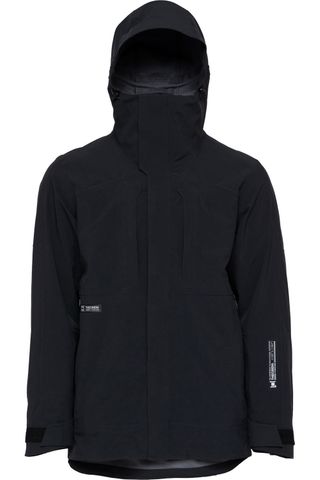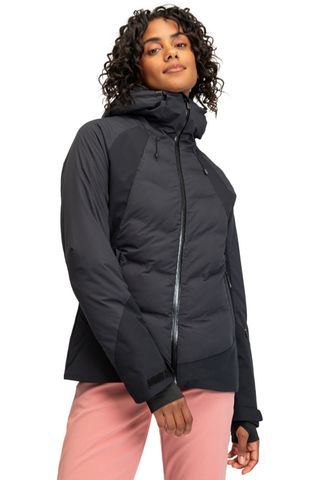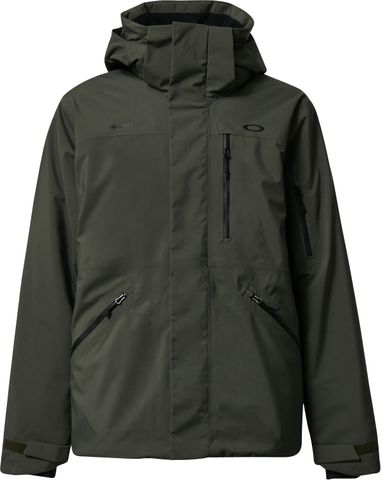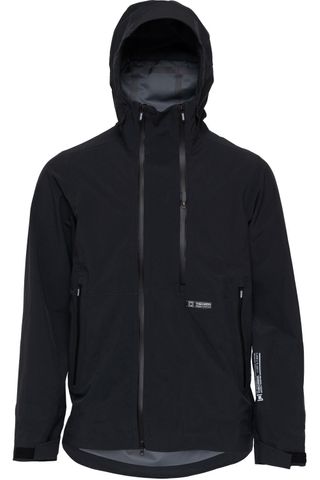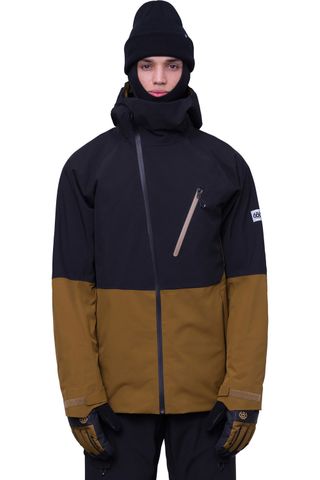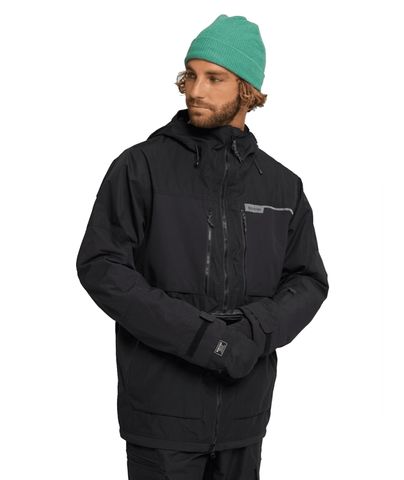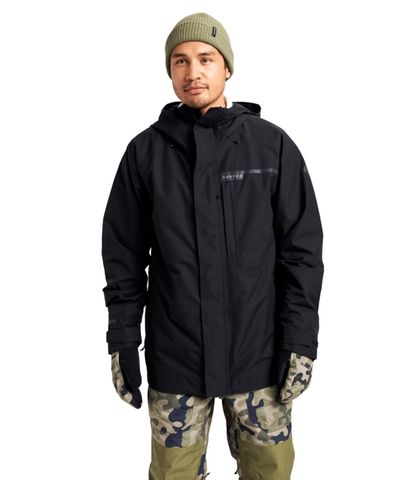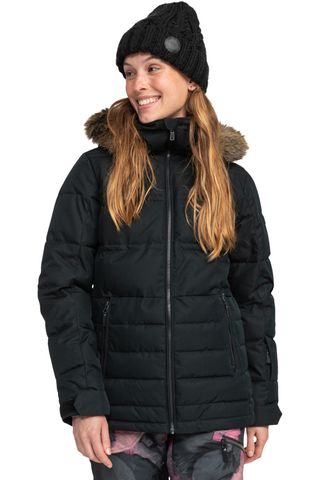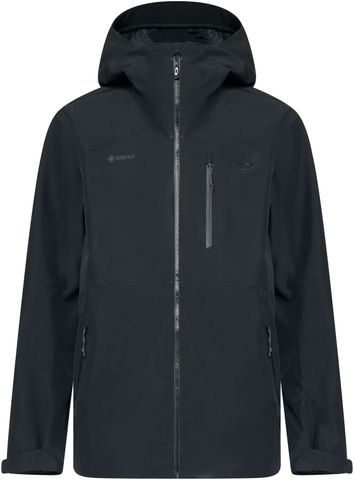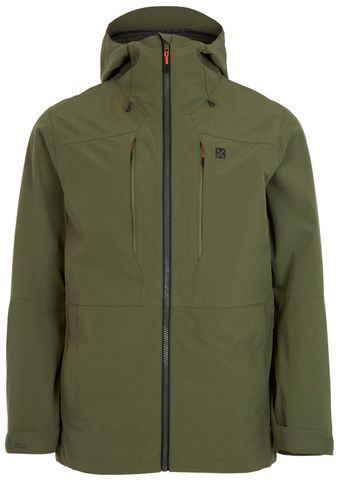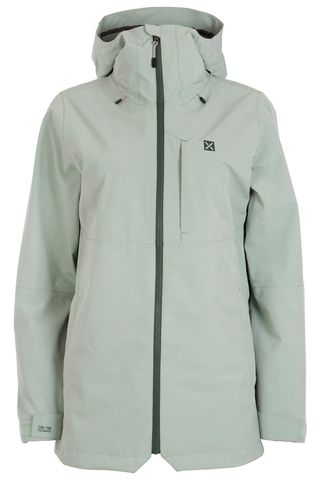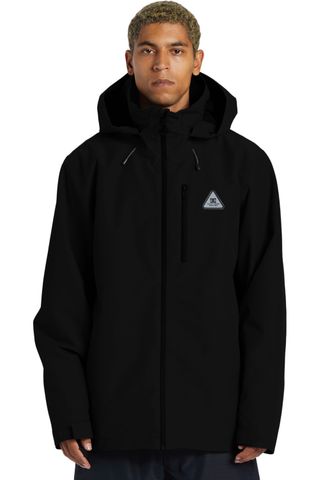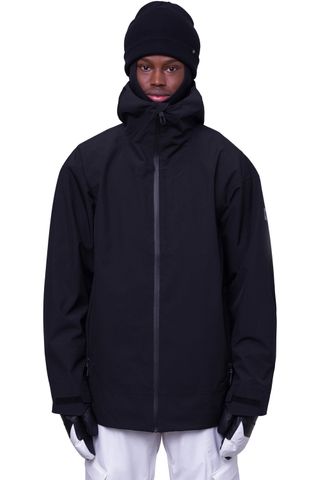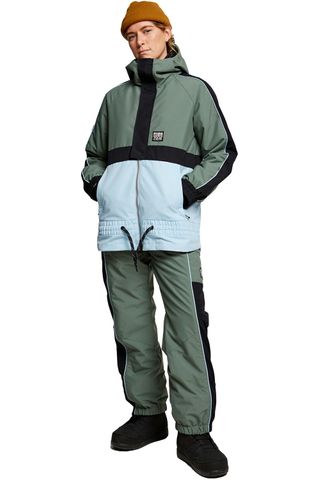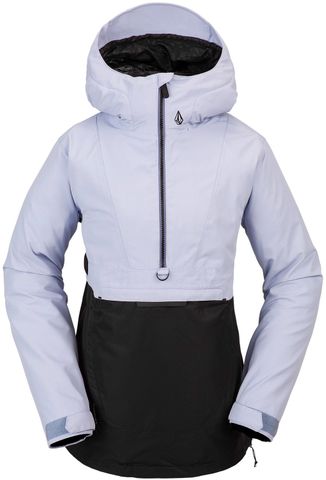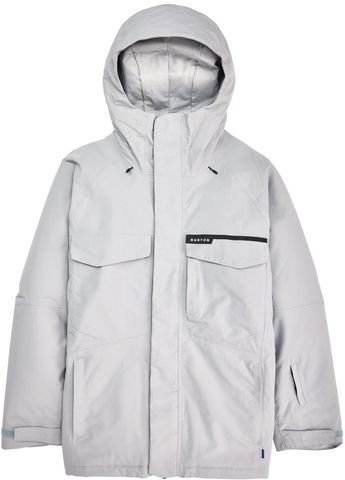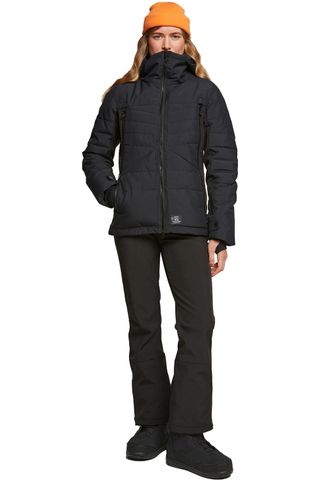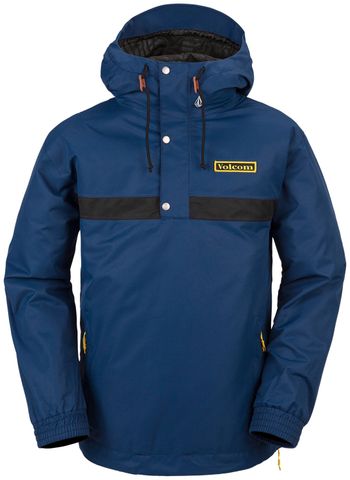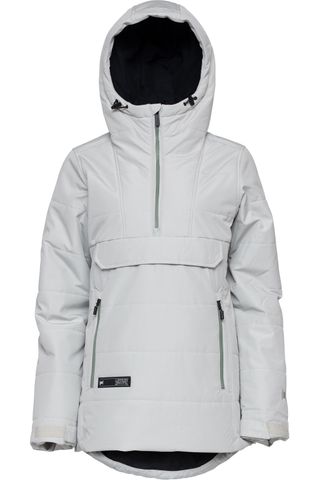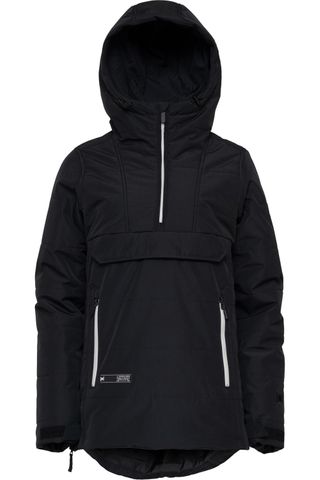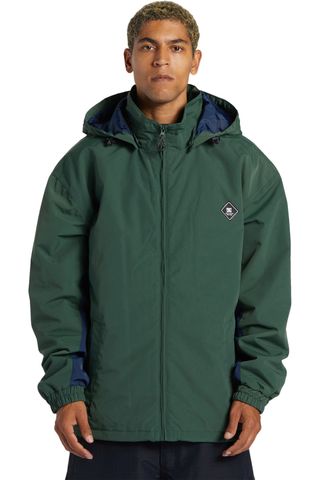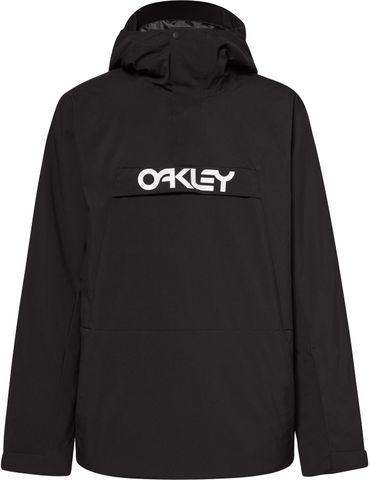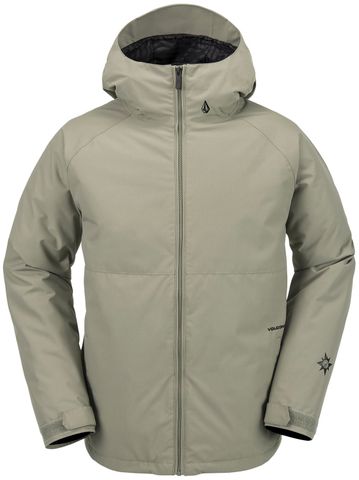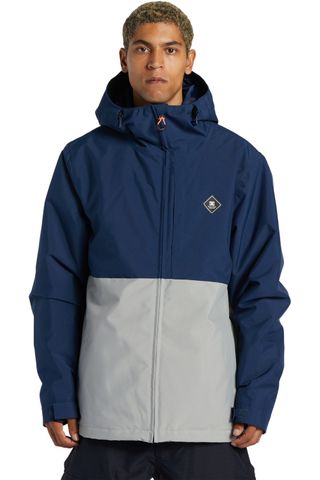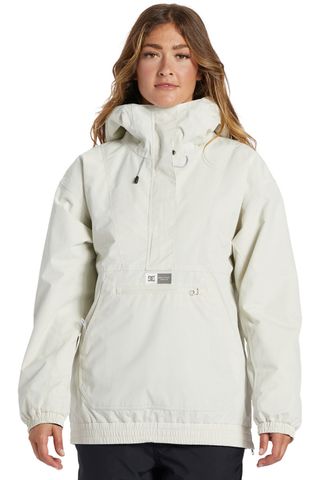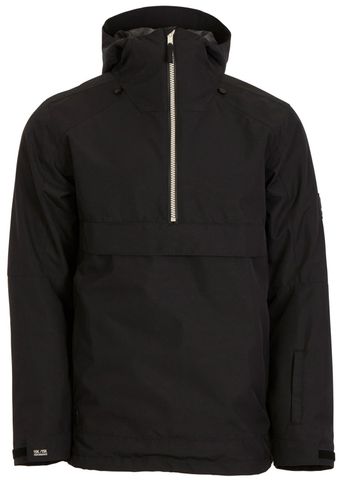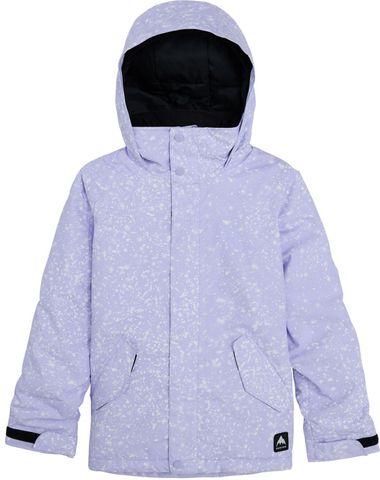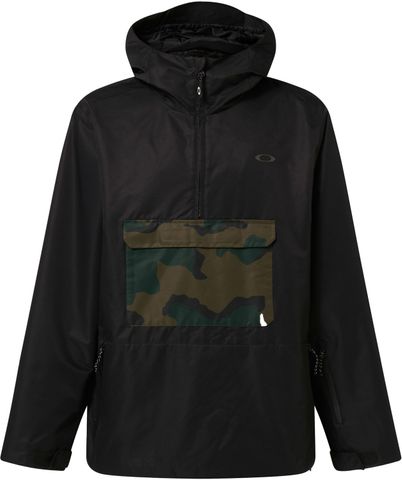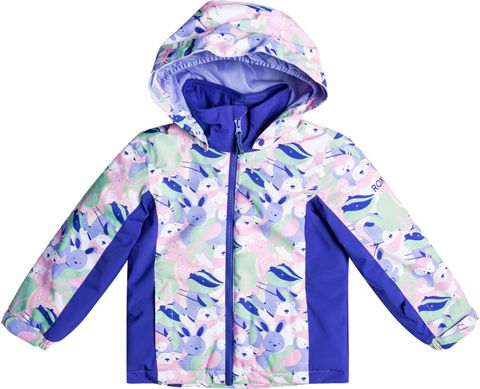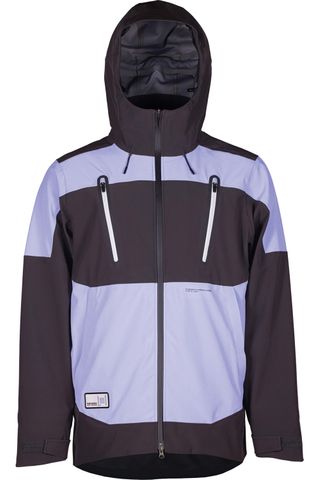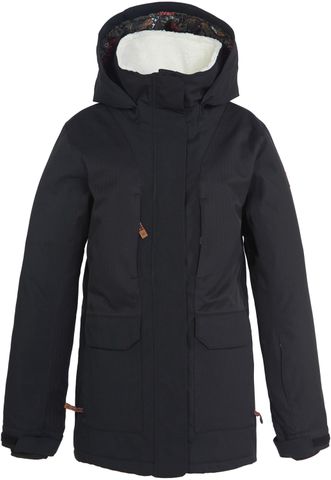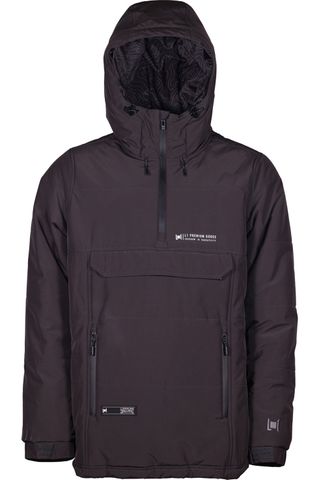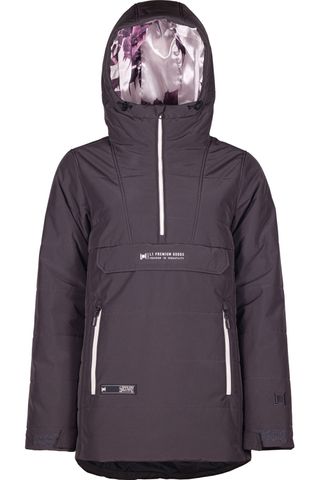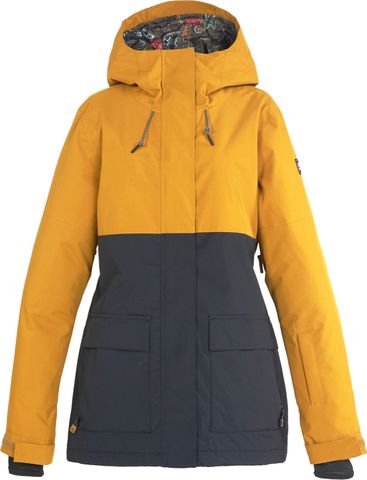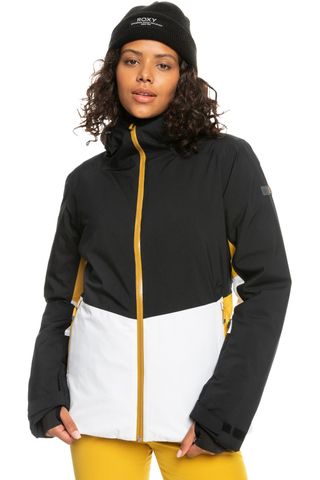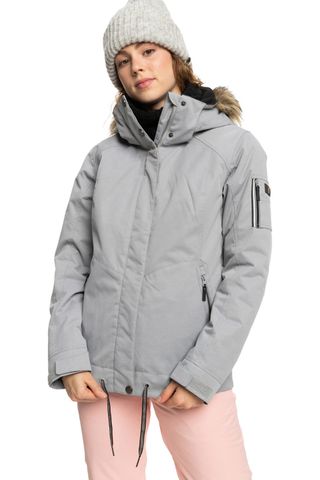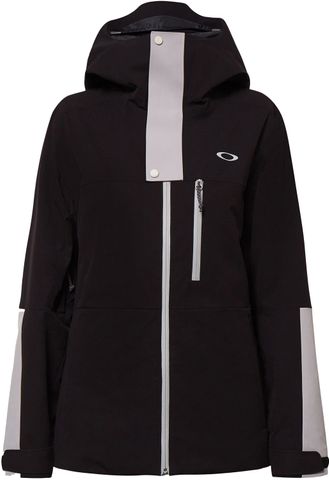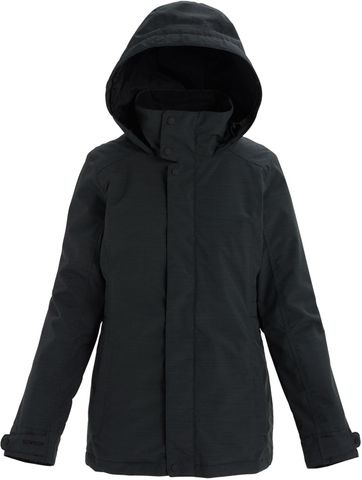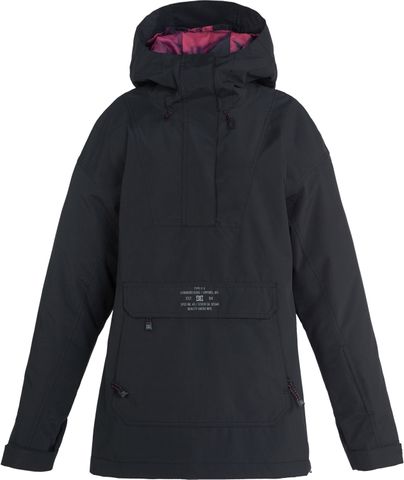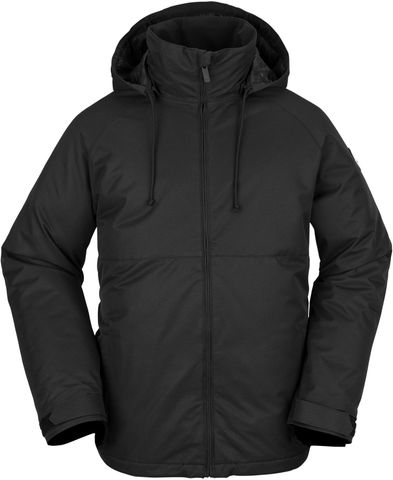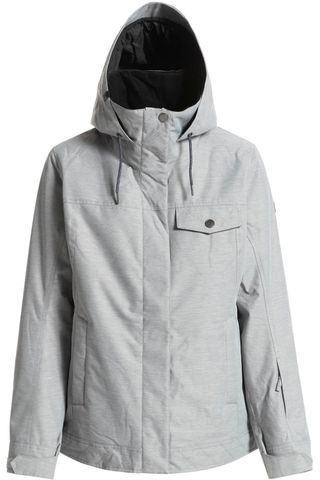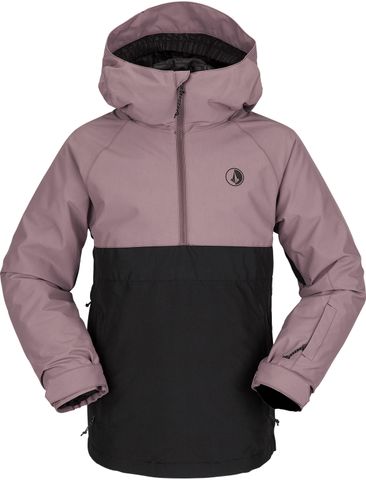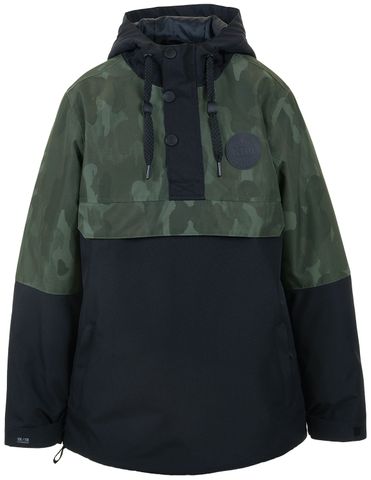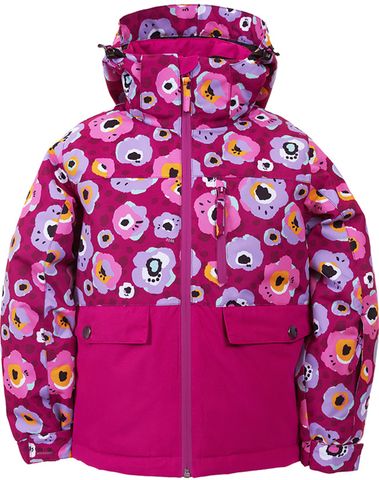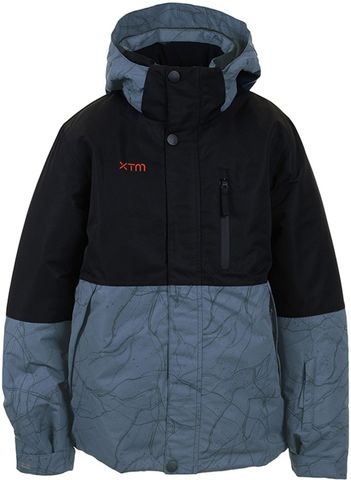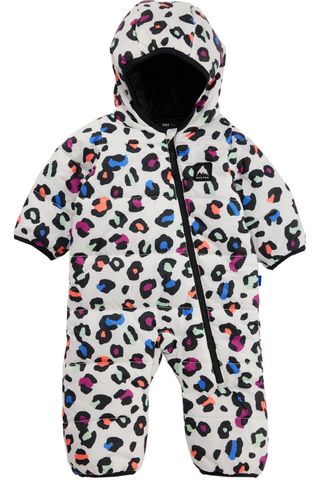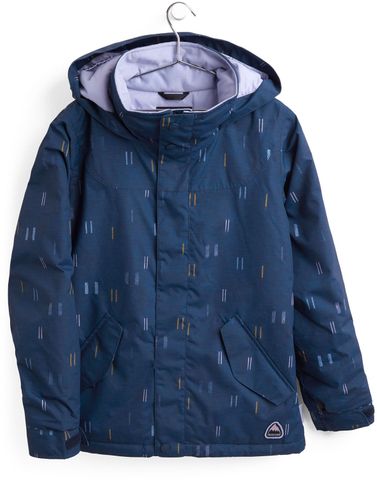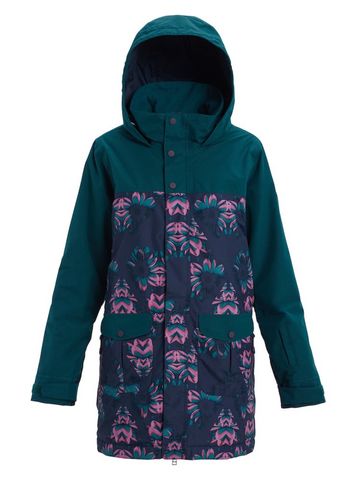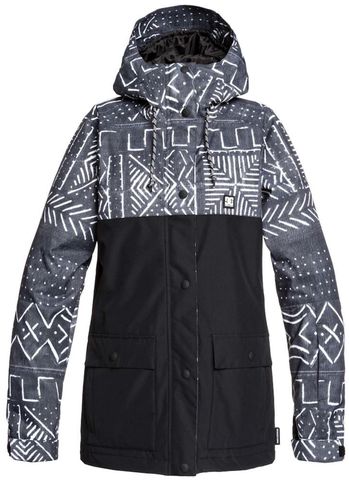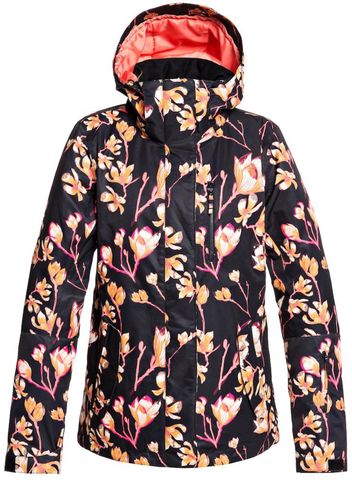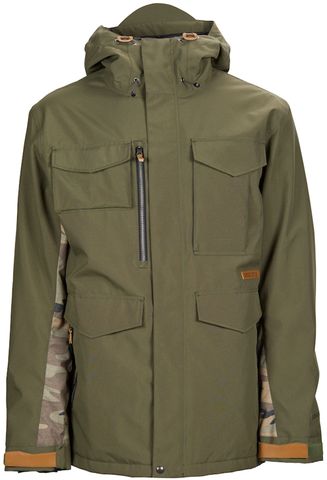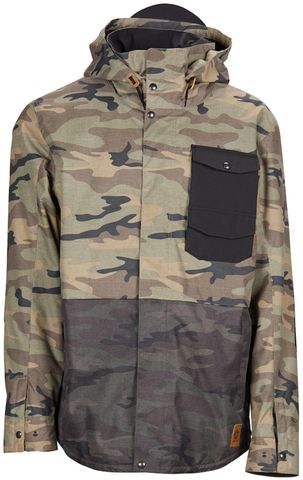Snow Jackets

Ski and snowboard jackets are designed to protect you from the elements such as wind, snow, ice, and rain, be functional by offering storage and compartments for items such as a ski pass or phone and offer a range of movement for comfort and performance while out in the mountains. Key technical features to differentiate jackets include waterproofing, breathability, and insulation.
- WATERPROOFING: Refers to the ability of the jacket to prevent water from penetrating through the fabric and getting to your skin or base layers. Snow jackets are typically made of materials and textiles that have been engineered to be highly resistant to water. The waterproofing ability of a snow jacket is typically measured in millimetres and is referred to as the "waterproof rating." This rating tells you how much water pressure the fabric can withstand before it starts to leak. For example, a jacket with a 10,000mm waterproof rating means it can withstand 10,000mm of water pressure before it starts to leak. A 10,000mm rating is a suitable standard for snow jackets, while a jacket with a rating of 20,000mm or 30,000mm is extremely waterproof. A jacket with a high waterproof rating will help to keep you dry and comfortable while you are skiing or snowboarding. In addition to the waterproof rating, snow jackets may also have additional waterproofing features like taped seams, waterproof zippers, and water-resistant coatings such as DWR that help to enhance the jacket's ability to repel water.
- BREATHABILITY: Refers to the jacket's ability to allow moisture vapor, such as sweat, to escape from inside the jacket. When you are skiing or snowboarding, your body generates heat and moisture, which can make you feel sweaty and uncomfortable. If this moisture is not able to escape from inside the jacket, it can make you feel damp and cold, despite a jacket having a high waterproof rating and heavy insulation. Snow jackets are designed to be breathable, meaning they allow moisture vapor to escape while still being waterproof. This is achieved with advanced fabrics and technologies that allow air and moisture to pass through the jacket while keeping water out. The breathability of a snow jacket is typically measured in grams and is referred to as the "breathability rating." This rating tells you how much moisture vapor the fabric can allow to escape per square meter in a 24-hour period. For example, a jacket with a 10,000g breathability rating means it can allow 10,000 grams of moisture vapor to escape per square meter in a 24-hour period.
- INSULATION: Refers to the material that is used to provide warmth and insulation against the cold weather. Insulation is designed to trap body heat inside the jacket and keep you warm in cold temperatures. The amount of insulation in a snow jacket is measured in grams per square meter, and jackets with higher insulation levels will typically be warmer but also heavier. The ideal amount of insulation will depend on the activity level, temperature, and personal preference. There are different kinds of insulation such as synthetic and down. Nearly all snow jackets use synthetic insulation made from man-made fibres such as polyester as they retain heat while wet and cost less compared to natural down insulation.
- SHELL JACKETS: A shell jacket is designed to be worn as an outer layer over other layers of clothing. Unlike insulated jackets, shell jackets do not have any built-in insulation, but rather are made from lightweight, waterproof, and breathable materials such as Gore-Tex that provide protection from the elements without adding extra bulk or weight. They often have features such as adjustable hoods, cuffs, and hemlines, as well as zippered vents that can be opened to release excess heat and moisture. The main advantage of a shell snow jacket is its versatility. Because they do not have any built-in insulation, they can be worn in a wide range of temperatures and weather conditions. In mild weather, they can be worn over a single layer, while in colder weather, they can be worn over multiple layers of clothing or thermals to provide extra warmth.
- GORE-TEX: Gore-Tex is a high-performance fabric technology that is commonly used in snow jackets and other outdoor gear. It is a waterproof and breathable fabric that is designed to provide protection from the elements while still allowing moisture vapor to escape from inside the jacket. The Gore-Tex membrane is made up of microscopic pores that are much smaller than water droplets, but larger than water vapor molecules. This means that water is not able to penetrate the membrane from the outside, but sweat and other moisture vapor can escape from the inside of the jacket, keeping the wearer dry and comfortable. Gore-Tex is designed to be lightweight and packable, making it a popular choice for backcountry skiers and snowboarders. In addition to its waterproof and breathable properties, Gore-Tex is also windproof, which helps to provide extra protection from the elements.








![Burton 2024 [Ak] Hover GORE-TEX 3L Stretch Jacket Burton 2024 [Ak] Hover GORE-TEX 3L Stretch Jacket](https://d1mv2b9v99cq0i.cloudfront.net/eyJidWNrZXQiOiJ3ZWItbmluamEtaW1hZ2VzIiwia2V5Ijoid3JvbmxpbmVcL2ltYWdlc1wvcHJvZGltZ1wvMTYxNTg4XzEuanBnIiwiZWRpdHMiOnsicmVzaXplIjp7IndpZHRoIjo0ODAsImhlaWdodCI6NDgwLCJmaXQiOiJpbnNpZGUiLCJ3aXRob3V0RW5sYXJnZW1lbnQiOnRydWV9fSwidmVyc2lvbiI6ImFkYzQ4OTAyOTM4NTVjN2NlNzMwYzgzNDIzNTZlZmQ1ZjZiMjk3MjcifQ==)
![Burton 2024 [Ak] Hover GORE-TEX 3L Stretch Jacket Burton 2024 [Ak] Hover GORE-TEX 3L Stretch Jacket](https://d1mv2b9v99cq0i.cloudfront.net/eyJidWNrZXQiOiJ3ZWItbmluamEtaW1hZ2VzIiwia2V5Ijoid3JvbmxpbmVcL2ltYWdlc1wvcHJvZGltZ1wvMTYxNTkwXzEuanBnIiwiZWRpdHMiOnsicmVzaXplIjp7IndpZHRoIjoyNywiaGVpZ2h0IjoyNywiZml0IjoiaW5zaWRlIiwid2l0aG91dEVubGFyZ2VtZW50Ijp0cnVlfX0sInZlcnNpb24iOiJhZGM0ODkwMjkzODU1YzdjZTczMGM4MzQyMzU2ZWZkNWY2YjI5NzI3In0=)
![Burton 2024 [Ak] Hover GORE-TEX 3L Stretch Jacket Burton 2024 [Ak] Hover GORE-TEX 3L Stretch Jacket](https://d1mv2b9v99cq0i.cloudfront.net/eyJidWNrZXQiOiJ3ZWItbmluamEtaW1hZ2VzIiwia2V5Ijoid3JvbmxpbmVcL2ltYWdlc1wvcHJvZGltZ1wvMTYyMTg1XzEuanBnIiwiZWRpdHMiOnsicmVzaXplIjp7IndpZHRoIjoyNywiaGVpZ2h0IjoyNywiZml0IjoiaW5zaWRlIiwid2l0aG91dEVubGFyZ2VtZW50Ijp0cnVlfX0sInZlcnNpb24iOiI2OWZkOWFiYzkyNzhjZWYxYWM1OWViNTQ3NzYxZDY3YTMyYmMzZTdhIn0=)
![Burton 2024 Womens [Ak] Embark GORE-TEX 2L Jacket Burton 2024 Womens [Ak] Embark GORE-TEX 2L Jacket](https://d1mv2b9v99cq0i.cloudfront.net/eyJidWNrZXQiOiJ3ZWItbmluamEtaW1hZ2VzIiwia2V5Ijoid3JvbmxpbmVcL2ltYWdlc1wvcHJvZGltZ1wvMTM1NjQxXzEuanBnIiwiZWRpdHMiOnsicmVzaXplIjp7IndpZHRoIjo0ODAsImhlaWdodCI6NDgwLCJmaXQiOiJpbnNpZGUiLCJ3aXRob3V0RW5sYXJnZW1lbnQiOnRydWV9fSwidmVyc2lvbiI6IjFlNTA3NzMzNDA3ZjRjMDFkMGE5MGE0MzI3NjA5YmI4ZGRkNDcwYzQifQ==)
![Burton 2024 Womens [Ak] Embark GORE-TEX 2L Jacket Burton 2024 Womens [Ak] Embark GORE-TEX 2L Jacket](https://d1mv2b9v99cq0i.cloudfront.net/eyJidWNrZXQiOiJ3ZWItbmluamEtaW1hZ2VzIiwia2V5Ijoid3JvbmxpbmVcL2ltYWdlc1wvcHJvZGltZ1wvMTYxNjE4XzEuanBnIiwiZWRpdHMiOnsicmVzaXplIjp7IndpZHRoIjoyNywiaGVpZ2h0IjoyNywiZml0IjoiaW5zaWRlIiwid2l0aG91dEVubGFyZ2VtZW50Ijp0cnVlfX0sInZlcnNpb24iOiIxZTUwNzczMzQwN2Y0YzAxZDBhOTBhNDMyNzYwOWJiOGRkZDQ3MGM0In0=)
![Burton 2024 Womens [Ak] Embark GORE-TEX 2L Jacket Burton 2024 Womens [Ak] Embark GORE-TEX 2L Jacket](https://d1mv2b9v99cq0i.cloudfront.net/eyJidWNrZXQiOiJ3ZWItbmluamEtaW1hZ2VzIiwia2V5Ijoid3JvbmxpbmVcL2ltYWdlc1wvcHJvZGltZ1wvMTYxODcwXzEuanBnIiwiZWRpdHMiOnsicmVzaXplIjp7IndpZHRoIjoyNywiaGVpZ2h0IjoyNywiZml0IjoiaW5zaWRlIiwid2l0aG91dEVubGFyZ2VtZW50Ijp0cnVlfX0sInZlcnNpb24iOiJmYzI4YTBhNWVhNGM0NWJlZjNiMjRkMzkzZDc1NTljZjdjYTE0NTEyIn0=)
![Burton 2024 Womens [Ak] Embark GORE-TEX 2L Jacket Burton 2024 Womens [Ak] Embark GORE-TEX 2L Jacket](https://d1mv2b9v99cq0i.cloudfront.net/eyJidWNrZXQiOiJ3ZWItbmluamEtaW1hZ2VzIiwia2V5Ijoid3JvbmxpbmVcL2ltYWdlc1wvcHJvZGltZ1wvMTYxODczXzEuanBnIiwiZWRpdHMiOnsicmVzaXplIjp7IndpZHRoIjoyNywiaGVpZ2h0IjoyNywiZml0IjoiaW5zaWRlIiwid2l0aG91dEVubGFyZ2VtZW50Ijp0cnVlfX0sInZlcnNpb24iOiIxNzk5OGFkNDUwZTM3Y2IxZTUyNmIwZDEwNWYwYzU4OGJiNjQzNzQ0In0=)
![Burton 2024 [Ak] Swash GORE-TEX 2L Jacket Burton 2024 [Ak] Swash GORE-TEX 2L Jacket](https://d1mv2b9v99cq0i.cloudfront.net/eyJidWNrZXQiOiJ3ZWItbmluamEtaW1hZ2VzIiwia2V5Ijoid3JvbmxpbmVcL2ltYWdlc1wvcHJvZGltZ1wvMTYxNTk5XzEuanBnIiwiZWRpdHMiOnsicmVzaXplIjp7IndpZHRoIjo0ODAsImhlaWdodCI6NDgwLCJmaXQiOiJpbnNpZGUiLCJ3aXRob3V0RW5sYXJnZW1lbnQiOnRydWV9fSwidmVyc2lvbiI6IjIxNTk5OWU3N2E1NDBlODFiOTdlNDlhNzBhNGM2YzhhZGZmNjc2MDYifQ==)
![Burton 2024 [Ak] Swash GORE-TEX 2L Jacket Burton 2024 [Ak] Swash GORE-TEX 2L Jacket](https://d1mv2b9v99cq0i.cloudfront.net/eyJidWNrZXQiOiJ3ZWItbmluamEtaW1hZ2VzIiwia2V5Ijoid3JvbmxpbmVcL2ltYWdlc1wvcHJvZGltZ1wvMTYxNjAxXzEuanBnIiwiZWRpdHMiOnsicmVzaXplIjp7IndpZHRoIjoyNywiaGVpZ2h0IjoyNywiZml0IjoiaW5zaWRlIiwid2l0aG91dEVubGFyZ2VtZW50Ijp0cnVlfX0sInZlcnNpb24iOiIyMTU5OTllNzdhNTQwZTgxYjk3ZTQ5YTcwYTRjNmM4YWRmZjY3NjA2In0=)
![Burton 2024 [Ak] Swash GORE-TEX 2L Jacket Burton 2024 [Ak] Swash GORE-TEX 2L Jacket](https://d1mv2b9v99cq0i.cloudfront.net/eyJidWNrZXQiOiJ3ZWItbmluamEtaW1hZ2VzIiwia2V5Ijoid3JvbmxpbmVcL2ltYWdlc1wvcHJvZGltZ1wvMTYxODU5XzEuanBnIiwiZWRpdHMiOnsicmVzaXplIjp7IndpZHRoIjoyNywiaGVpZ2h0IjoyNywiZml0IjoiaW5zaWRlIiwid2l0aG91dEVubGFyZ2VtZW50Ijp0cnVlfX0sInZlcnNpb24iOiI4NzQ1NjNmZDhhNTg1ZjUwNzAyOTU4MTNkMzBhOGFmNjI5NmE1M2ViIn0=)
![Burton 2024 [Ak] Swash GORE-TEX 2L Jacket Burton 2024 [Ak] Swash GORE-TEX 2L Jacket](https://d1mv2b9v99cq0i.cloudfront.net/eyJidWNrZXQiOiJ3ZWItbmluamEtaW1hZ2VzIiwia2V5Ijoid3JvbmxpbmVcL2ltYWdlc1wvcHJvZGltZ1wvMTYxODYyXzEuanBnIiwiZWRpdHMiOnsicmVzaXplIjp7IndpZHRoIjoyNywiaGVpZ2h0IjoyNywiZml0IjoiaW5zaWRlIiwid2l0aG91dEVubGFyZ2VtZW50Ijp0cnVlfX0sInZlcnNpb24iOiIxMGVhNjVjZDE5MTJjOGUzYWU4MTAzZWQ5MmM4NzAyYjg2ZTZiMjUxIn0=)
![Burton 2024 [Ak] Swash GORE-TEX 2L Jacket Burton 2024 [Ak] Swash GORE-TEX 2L Jacket](https://d1mv2b9v99cq0i.cloudfront.net/eyJidWNrZXQiOiJ3ZWItbmluamEtaW1hZ2VzIiwia2V5Ijoid3JvbmxpbmVcL2ltYWdlc1wvcHJvZGltZ1wvMTYyMTg5XzEuanBnIiwiZWRpdHMiOnsicmVzaXplIjp7IndpZHRoIjoyNywiaGVpZ2h0IjoyNywiZml0IjoiaW5zaWRlIiwid2l0aG91dEVubGFyZ2VtZW50Ijp0cnVlfX0sInZlcnNpb24iOiJiYjMwNTMwZGE3OWM2NGJmMDY5ZjU0NzBlZGMyYmMwMmVkNmIwZDNhIn0=)
![Burton 2024 [Ak] Swash GORE-TEX 2L Jacket Burton 2024 [Ak] Swash GORE-TEX 2L Jacket](https://d1mv2b9v99cq0i.cloudfront.net/eyJidWNrZXQiOiJ3ZWItbmluamEtaW1hZ2VzIiwia2V5Ijoid3JvbmxpbmVcL2ltYWdlc1wvcHJvZGltZ1wvMTYyMTkzXzEuanBnIiwiZWRpdHMiOnsicmVzaXplIjp7IndpZHRoIjoyNywiaGVpZ2h0IjoyNywiZml0IjoiaW5zaWRlIiwid2l0aG91dEVubGFyZ2VtZW50Ijp0cnVlfX0sInZlcnNpb24iOiI1Mjc1NjIwMjMwNzM4MTIyOGRjNTNiOGI0MDU5YzQ3ZGE2NmY0ZGZlIn0=)
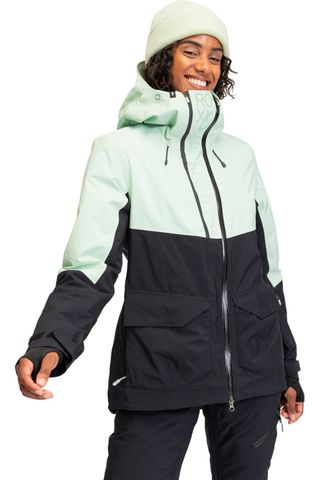
![Burton 2024 [Ak] Cyclic GORE-TEX 2L Jacket Burton 2024 [Ak] Cyclic GORE-TEX 2L Jacket](https://d1mv2b9v99cq0i.cloudfront.net/eyJidWNrZXQiOiJ3ZWItbmluamEtaW1hZ2VzIiwia2V5Ijoid3JvbmxpbmVcL2ltYWdlc1wvcHJvZGltZ1wvMTYxNTkxXzEuanBnIiwiZWRpdHMiOnsicmVzaXplIjp7IndpZHRoIjo0ODAsImhlaWdodCI6NDgwLCJmaXQiOiJpbnNpZGUiLCJ3aXRob3V0RW5sYXJnZW1lbnQiOnRydWV9fSwidmVyc2lvbiI6Ijg1OTY2Mjg0MDczMWRiNDA0NGJmYTI4ZTUxZTM0MTgzZmFmMTQ5YzMifQ==)
![Burton 2024 [Ak] Cyclic GORE-TEX 2L Jacket Burton 2024 [Ak] Cyclic GORE-TEX 2L Jacket](https://d1mv2b9v99cq0i.cloudfront.net/eyJidWNrZXQiOiJ3ZWItbmluamEtaW1hZ2VzIiwia2V5Ijoid3JvbmxpbmVcL2ltYWdlc1wvcHJvZGltZ1wvMTYxNTk0XzEuanBnIiwiZWRpdHMiOnsicmVzaXplIjp7IndpZHRoIjoyNywiaGVpZ2h0IjoyNywiZml0IjoiaW5zaWRlIiwid2l0aG91dEVubGFyZ2VtZW50Ijp0cnVlfX0sInZlcnNpb24iOiI4NTk2NjI4NDA3MzFkYjQwNDRiZmEyOGU1MWUzNDE4M2ZhZjE0OWMzIn0=)
![Burton 2024 [Ak] Cyclic GORE-TEX 2L Jacket Burton 2024 [Ak] Cyclic GORE-TEX 2L Jacket](https://d1mv2b9v99cq0i.cloudfront.net/eyJidWNrZXQiOiJ3ZWItbmluamEtaW1hZ2VzIiwia2V5Ijoid3JvbmxpbmVcL2ltYWdlc1wvcHJvZGltZ1wvMTYxNTk4XzEuanBnIiwiZWRpdHMiOnsicmVzaXplIjp7IndpZHRoIjoyNywiaGVpZ2h0IjoyNywiZml0IjoiaW5zaWRlIiwid2l0aG91dEVubGFyZ2VtZW50Ijp0cnVlfX0sInZlcnNpb24iOiJmODUyMzU0MDkwYWM1MmFlYWEwZGNlZDE0ZjJjMzBkZDM1MTZhODVkIn0=)
![Burton 2024 [Ak] Cyclic GORE-TEX 2L Jacket Burton 2024 [Ak] Cyclic GORE-TEX 2L Jacket](https://d1mv2b9v99cq0i.cloudfront.net/eyJidWNrZXQiOiJ3ZWItbmluamEtaW1hZ2VzIiwia2V5Ijoid3JvbmxpbmVcL2ltYWdlc1wvcHJvZGltZ1wvMTYxODY3XzEuanBnIiwiZWRpdHMiOnsicmVzaXplIjp7IndpZHRoIjoyNywiaGVpZ2h0IjoyNywiZml0IjoiaW5zaWRlIiwid2l0aG91dEVubGFyZ2VtZW50Ijp0cnVlfX0sInZlcnNpb24iOiJkOGM3ZmUzMWRjNGIyNjNkNjNhYTNjN2UzMGNiNTI5OTBjZjNiNTYwIn0=)
![Burton 2024 [Ak] Cyclic GORE-TEX 2L Jacket Burton 2024 [Ak] Cyclic GORE-TEX 2L Jacket](https://d1mv2b9v99cq0i.cloudfront.net/eyJidWNrZXQiOiJ3ZWItbmluamEtaW1hZ2VzIiwia2V5Ijoid3JvbmxpbmVcL2ltYWdlc1wvcHJvZGltZ1wvMTYyMTk3XzEuanBnIiwiZWRpdHMiOnsicmVzaXplIjp7IndpZHRoIjoyNywiaGVpZ2h0IjoyNywiZml0IjoiaW5zaWRlIiwid2l0aG91dEVubGFyZ2VtZW50Ijp0cnVlfX0sInZlcnNpb24iOiI4ZTI0NzBjMjRiNTUyMTQ3Y2FjNjQ0NzkwNDc0ODhjMmRiZjQzZWJjIn0=)
![Burton 2024 [Ak] Cyclic GORE-TEX 2L Jacket Burton 2024 [Ak] Cyclic GORE-TEX 2L Jacket](https://d1mv2b9v99cq0i.cloudfront.net/eyJidWNrZXQiOiJ3ZWItbmluamEtaW1hZ2VzIiwia2V5Ijoid3JvbmxpbmVcL2ltYWdlc1wvcHJvZGltZ1wvMTYyMjAxXzEuanBnIiwiZWRpdHMiOnsicmVzaXplIjp7IndpZHRoIjoyNywiaGVpZ2h0IjoyNywiZml0IjoiaW5zaWRlIiwid2l0aG91dEVubGFyZ2VtZW50Ijp0cnVlfX0sInZlcnNpb24iOiI4NjRiYjMwZTg0Y2NiNWFlMDAzMjU1NjUxMGY0ZGQ1MjFjZWI3NGI3In0=)
![Burton 2024 Womens [Ak] Upshift GORE-TEX 2L Jacket Burton 2024 Womens [Ak] Upshift GORE-TEX 2L Jacket](https://d1mv2b9v99cq0i.cloudfront.net/eyJidWNrZXQiOiJ3ZWItbmluamEtaW1hZ2VzIiwia2V5Ijoid3JvbmxpbmVcL2ltYWdlc1wvcHJvZGltZ1wvMTYxNjE5XzEuanBnIiwiZWRpdHMiOnsicmVzaXplIjp7IndpZHRoIjo0ODAsImhlaWdodCI6NDgwLCJmaXQiOiJpbnNpZGUiLCJ3aXRob3V0RW5sYXJnZW1lbnQiOnRydWV9fSwidmVyc2lvbiI6Ijg5OThjNTlmYTBjZjg2MGI3NzlmMDBmNGU2NzM1NGZiOWQ1NzlkZGYifQ==)
![Burton 2024 Womens [Ak] Upshift GORE-TEX 2L Jacket Burton 2024 Womens [Ak] Upshift GORE-TEX 2L Jacket](https://d1mv2b9v99cq0i.cloudfront.net/eyJidWNrZXQiOiJ3ZWItbmluamEtaW1hZ2VzIiwia2V5Ijoid3JvbmxpbmVcL2ltYWdlc1wvcHJvZGltZ1wvMTYxNjIxXzEuanBnIiwiZWRpdHMiOnsicmVzaXplIjp7IndpZHRoIjoyNywiaGVpZ2h0IjoyNywiZml0IjoiaW5zaWRlIiwid2l0aG91dEVubGFyZ2VtZW50Ijp0cnVlfX0sInZlcnNpb24iOiI4OTk4YzU5ZmEwY2Y4NjBiNzc5ZjAwZjRlNjczNTRmYjlkNTc5ZGRmIn0=)
![Burton 2024 Womens [Ak] Upshift GORE-TEX 2L Jacket Burton 2024 Womens [Ak] Upshift GORE-TEX 2L Jacket](https://d1mv2b9v99cq0i.cloudfront.net/eyJidWNrZXQiOiJ3ZWItbmluamEtaW1hZ2VzIiwia2V5Ijoid3JvbmxpbmVcL2ltYWdlc1wvcHJvZGltZ1wvMTYxODc5XzEuanBnIiwiZWRpdHMiOnsicmVzaXplIjp7IndpZHRoIjoyNywiaGVpZ2h0IjoyNywiZml0IjoiaW5zaWRlIiwid2l0aG91dEVubGFyZ2VtZW50Ijp0cnVlfX0sInZlcnNpb24iOiJlNDkwOTVlOTdiMWE3ODI2NWM3MDBiYTI3N2Q1YjdkOTRkMjY3ZGIyIn0=)
![Burton 2024 Womens [Ak] Upshift GORE-TEX 2L Jacket Burton 2024 Womens [Ak] Upshift GORE-TEX 2L Jacket](https://d1mv2b9v99cq0i.cloudfront.net/eyJidWNrZXQiOiJ3ZWItbmluamEtaW1hZ2VzIiwia2V5Ijoid3JvbmxpbmVcL2ltYWdlc1wvcHJvZGltZ1wvMTYyMjA1XzEuanBnIiwiZWRpdHMiOnsicmVzaXplIjp7IndpZHRoIjoyNywiaGVpZ2h0IjoyNywiZml0IjoiaW5zaWRlIiwid2l0aG91dEVubGFyZ2VtZW50Ijp0cnVlfX0sInZlcnNpb24iOiI0Y2Q0NDgzMGZjY2U0ZjM5MWI5YTJkMWQwOGE4MTM1NjdiYWQ0MzQzIn0=)
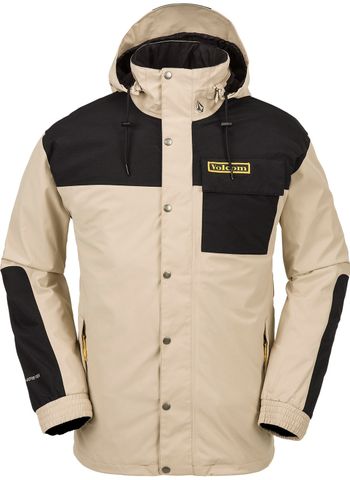
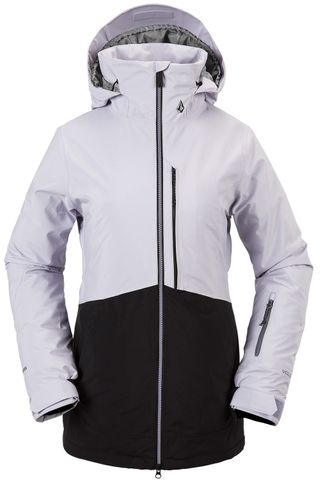





![Burton 2024 [Ak] Velocity GORE-TEX 2L Anorak Jacket Burton 2024 [Ak] Velocity GORE-TEX 2L Anorak Jacket](https://d1mv2b9v99cq0i.cloudfront.net/eyJidWNrZXQiOiJ3ZWItbmluamEtaW1hZ2VzIiwia2V5Ijoid3JvbmxpbmVcL2ltYWdlc1wvcHJvZGltZ1wvMTQyNzU4XzEuanBnIiwiZWRpdHMiOnsicmVzaXplIjp7IndpZHRoIjo0ODAsImhlaWdodCI6NDgwLCJmaXQiOiJpbnNpZGUiLCJ3aXRob3V0RW5sYXJnZW1lbnQiOnRydWV9fSwidmVyc2lvbiI6ImUxNzhhYjkxY2YwZjY5ODdlZGZhOGNiMTExYjFiOGNlMjhiNGEzOGMifQ==)
![Burton 2024 [Ak] Velocity GORE-TEX 2L Anorak Jacket Burton 2024 [Ak] Velocity GORE-TEX 2L Anorak Jacket](https://d1mv2b9v99cq0i.cloudfront.net/eyJidWNrZXQiOiJ3ZWItbmluamEtaW1hZ2VzIiwia2V5Ijoid3JvbmxpbmVcL2ltYWdlc1wvcHJvZGltZ1wvMTYxNjA0XzEuanBnIiwiZWRpdHMiOnsicmVzaXplIjp7IndpZHRoIjoyNywiaGVpZ2h0IjoyNywiZml0IjoiaW5zaWRlIiwid2l0aG91dEVubGFyZ2VtZW50Ijp0cnVlfX0sInZlcnNpb24iOiJlMTc4YWI5MWNmMGY2OTg3ZWRmYThjYjExMWIxYjhjZTI4YjRhMzhjIn0=)
![Burton 2024 [Ak] Velocity GORE-TEX 2L Anorak Jacket Burton 2024 [Ak] Velocity GORE-TEX 2L Anorak Jacket](https://d1mv2b9v99cq0i.cloudfront.net/eyJidWNrZXQiOiJ3ZWItbmluamEtaW1hZ2VzIiwia2V5Ijoid3JvbmxpbmVcL2ltYWdlc1wvcHJvZGltZ1wvMTYxODc3XzEuanBnIiwiZWRpdHMiOnsicmVzaXplIjp7IndpZHRoIjoyNywiaGVpZ2h0IjoyNywiZml0IjoiaW5zaWRlIiwid2l0aG91dEVubGFyZ2VtZW50Ijp0cnVlfX0sInZlcnNpb24iOiIyZWE0MWQ2OTBmZDdmODkwNDMwMzc2YjRmMmI0YjRlMDc2YmZhMTRlIn0=)
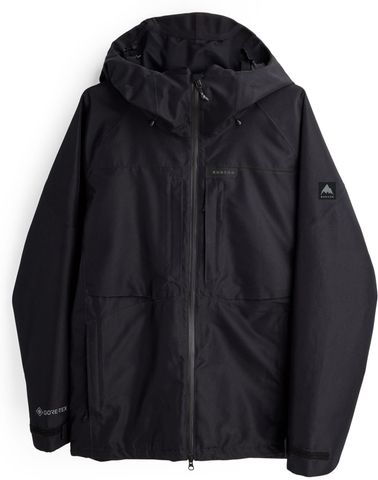
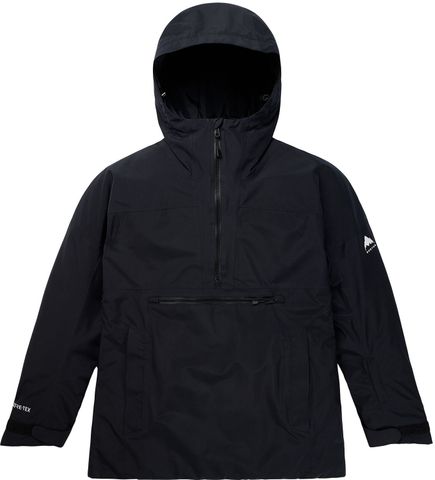


![Burton 2024 Womens [Ak] Kimmy GORE-TEX 2L Anorak Jacket Burton 2024 Womens [Ak] Kimmy GORE-TEX 2L Anorak Jacket](https://d1mv2b9v99cq0i.cloudfront.net/eyJidWNrZXQiOiJ3ZWItbmluamEtaW1hZ2VzIiwia2V5Ijoid3JvbmxpbmVcL2ltYWdlc1wvcHJvZGltZ1wvMTYyMjAyXzEuanBnIiwiZWRpdHMiOnsicmVzaXplIjp7IndpZHRoIjo0ODAsImhlaWdodCI6NDgwLCJmaXQiOiJpbnNpZGUiLCJ3aXRob3V0RW5sYXJnZW1lbnQiOnRydWV9fSwidmVyc2lvbiI6IjUzYWYyYTg5NTM3NmEyOWUyMGQyMWQyYjM1MmFjYTE1NDg4Nzc3ZjcifQ==)
